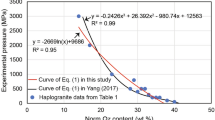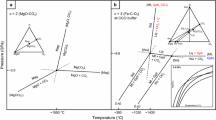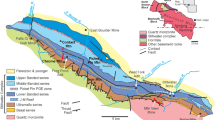Abstract
We performed modified iterative sandwich experiments (MISE) to determine the composition of carbonatitic melt generated near the solidus of natural, fertile peridotite + CO2 at 1,200–1,245°C and 6.6 GPa. Six iterations were performed with natural peridotite (MixKLB-1: Mg# = 89.7) and ∼10 wt% added carbonate to achieve the equilibrium carbonatite composition. Compositions of melts and coexisting minerals converged to a constant composition after the fourth iteration, with the silicate mineral compositions matching those expected at the solidus of carbonated peridotite at 6.6 GPa and 1,230°C, as determined from a sub-solidus experiment with MixKLB-1 peridotite. Partial melts expected from a carbonated lherzolite at a melt fraction of 0.01–0.05% at 6.6 GPa have the composition of sodic iron-bearing dolomitic carbonatite, with molar Ca/(Ca + Mg) of 0.413 ± 0.001, Ca# [100 × molar Ca/(Ca + Mg + Fe*)] of 37.1 ± 0.1, and Mg# of 83.7 ± 0.6. SiO2, TiO2 and Al2O3 concentrations are 4.1 ± 0.1, 1.0 ± 0.1, and 0.30 ± 0.02 wt%, whereas the Na2O concentration is 4.0 ± 0.2 wt%. Comparison of our results with other iterative sandwich experiments at lower pressures indicate that near-solidus carbonatite derived from mantle lherzolite become less calcic with increasing pressure. Thus carbonatitic melt percolating through the deep mantle must dissolve cpx from surrounding peridotite and precipitate opx. Significant FeO* and Na2O concentrations in near solidus carbonatitic partial melt likely account for the ∼150°C lower solidus temperature of natural carbonated peridotite compared to the solidus of synthetic peridotite in the system CMAS + CO2. The experiments demonstrate that the MISE method can determine the composition of partial melts at very low melt fraction after a small number of iterations.







Similar content being viewed by others
References
Brooker RA, Kohn SC, Holloway JR, McMillan PF (2001) Structural controls on the solubility of CO2 in silicate melts Part II: IR characteristics of carbonate groups in silicate glasses. Chem Geol 174:241–254
Canil D (1990) Experimental study bearing on the absence of carbonate in the mantle-derived xenoliths. Geology 18:1011–1013
Dalton JA, Presnall DC (1998) Carbonatitic melts along the solidus of model lherzolite in the system CaO-MgO-Al2O3−SiO2−CO2 from 3 to 7 GPa. Contrib Mineral Petrol 131:123–135
Dalton JA, Wood BJ (1993) The compositions of primary carbonate melt and their evolution through wallrock reaction in the mantle. Earth Planet Sci Lett 119:511–525
Dasgupta R (2006) Experimental investigation of mantle melting in the presence of carbonates. PhD Thesis. University of Minnesota, Minneapolis, p 247
Dasgupta R, Hirschmann MM (2006) Melting in the Earth’s deep upper mantle caused by carbon dioxide. Nature 440:659–662
Dasgupta R, Hirschmann MM (2007) Effect of variable carbonate concentration on the solidus of mantle peridotite. Am Mineral 92:370–379
Dasgupta R, Hirschmann MM, Withers AC (2004) Deep global cycling of carbon constrained by the solidus of anhydrous, carbonated eclogite under upper mantle conditions. Earth Planet Sci Lett 227:73–85
Dasgupta R, Hirschmann MM, Dellas N (2005) The effect of bulk composition on the solidus of carbonated eclogite from partial melting experiments at 3 GPa. Contrib Mineral Petrol 149:288–305
Dasgupta R, Hirschmann MM, Smith ND (2007) Water follows carbon: CO2 incites deep silicate melting and dehydration beneath mid-ocean ridges. Geology 35:135–138
Dixon JE, Stolper EM, Delaney JR (1988) Infrared spectroscopic measurements of CO2 and H2O in Juan de Fuca Ridge basaltic glasses. Earth Planet Sci Lett 90:87–104
Eggler DH (1976) Does CO2 cause partial melting in the low-velocity layer of the mantle? Geology 4:69–72
Gudfinnsson G, Presnall DC (2005) Continuous gradations among primary carbonatitic, kimberlitic, melilititic, basaltic, picritic, and komatiitic melts in equilibrium with garnet lherzolite at 3–8 GPa. J Petrol 46:1645–1659
Hammouda T, Laporte D (2000) Ultrafast melt impregnation by carbonatite melts. Geology 28:283–285
Hauri EH, Shimizu N, Dieu JJ, Hart SR (1993) Evidence for hotspot-related carbonatite metasomatism in the oceanic upper mantle. Nature 365:221–227
Hirschmann MM, Dasgupta R (2007) A modified iterative sandwich method for determination of near-solidus partial melt compositions. I. Theoretical considerations. Contrib Mineral Petrol doi:10.1007/s00410-007-0213-9
Hunter RH, McKenzie D (1989) The equilibrium geometry of carbonate melts in rocks of mantle composition. Earth Planet Sci Lett 92:347–356
Marty B, Tolstikhin IN (1998) CO2 fluxes from mid-ocean ridges, arcs and plumes. Chem Geol 145:233–248
Michael PJ (1988) The concentration, behavior and storage of H2O in the suboceanic upper mantle: implications for mantle metasomatism. Geochim Cosmochim Acta 52:555–566
Minarik WG, Watson EB (1995) Interconnectivity of carbonate melt at low melt fraction. Earth Planet Sci Lett 133:423–437
Moore KR, Wood BJ (1998) The transition from carbonate to silicate melts in the CaO–MgO–SiO2–CO2 system. J Petrol 39(11 & 12):1943–1951
Pineau F, Shilobreeva S, Hekinian R, Bidiau D, Javoy M (2004) Deep-sea explosive activity on the Mid-Atlantic Ridge near 34°50′N: a stable isotope (C, H, O) study. Chem Geol 211:159–175
Ryabchikov ID, Brey G, Kogarko LN, Bulatov VK (1989) Partial melting of carbonatized peridotite at 50 kbar. Geokhimiya 1:3–9
Saal AE, Hauri E, Langmuir CH, Perfit MR (2002) Vapour undersaturation in primitive mid-ocean-ridge basalt and the volatile content of Earth’s upper mantle. Nature 419:451–455
Sweeney RJ (1994) Carbonatite melt compositions in the Earth’s mantle. Earth Planet Sci Lett 128:259–270
Thibault Y, Edgar AD, Lloyd FE (1992) Experimental investigation of melts from a carbonated phlogopite lherzolite: Implications for metasomatism in the continental lithospheric mantle. Am Mineral 77:784–794
Wallace ME, Green DH (1988) An experimental determination of primary carbonatite magma composition. Nature 335:343–346
Workman RK, Hart SR (2005) Major and trace element composition of the depleted MORB mantle (DMM). Earth Planet Sci Lett 231:53–72
Wyllie PJ, Huang W-L (1975) Influence of mantle CO2 in the generation of carbonatites and kimberlites. Nature 257:297–299
Yaxley GM, Brey GP (2004) Phase relations of carbonate-bearing eclogite assemblages from 2.5 to 5.5 GPa: implications for petrogenesis of carbonatites. Contrib Mineral Petrol 146:606–619
Yaxley GM, Green DH, Kamenetsky V (1998) Carbonatite metasomatism in the southern Australian lithosphere. J Petrol 39:1917–1930
Acknowledgments
We are thankful to an anonymous referee for constructive reviews. RD acknowledges support of the Graduate School of University of Minnesota through a Doctoral Dissertation Fellowship towards the early part of this study and Lamont-Doherty Earth Observatory of Columbia University for a post-doctoral research fellowship during preparation of the manuscript. The work also received support from NSF grants EAR 0310142 and EAR 0609967 to MMH.
Author information
Authors and Affiliations
Corresponding author
Additional information
Communicated by T.L. Grove.
Rights and permissions
About this article
Cite this article
Dasgupta, R., Hirschmann, M.M. A modified iterative sandwich method for determination of near-solidus partial melt compositions. II. Application to determination of near-solidus melt compositions of carbonated peridotite. Contrib Mineral Petrol 154, 647–661 (2007). https://doi.org/10.1007/s00410-007-0214-8
Received:
Accepted:
Published:
Issue Date:
DOI: https://doi.org/10.1007/s00410-007-0214-8




